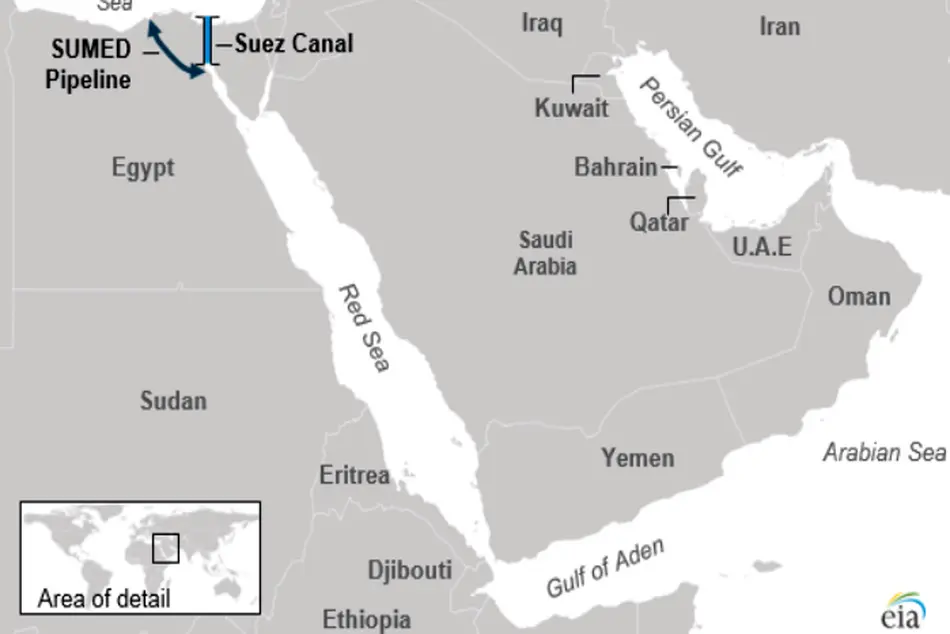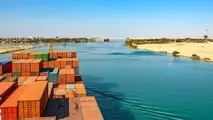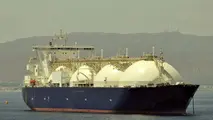Suez Canal a critical chokepoint for oil and natural gas trade
As EIA informs, the Suez Canal and the SUMED Pipeline are strategic routes for Persian Gulf crude oil, petroleum products, and LNG shipments to Europe and North America. Located in Egypt, the Suez Canal connects the Red Sea with the Mediterranean Sea, and is considered as a key chokepoint due to the large volumes of energy commodities that flow through it.

As EIA informs, the Suez Canal and the SUMED Pipeline are strategic routes for Persian Gulf crude oil, petroleum products, and LNG shipments to Europe and North America. Located in Egypt, the Suez Canal connects the Red Sea with the Mediterranean Sea, and is considered as a key chokepoint due to the large volumes of energy commodities that flow through it.
Total oil flows through the Suez Canal and the SUMED pipeline accounted for about 9% of total seaborne traded petroleum in 2017, and LNG flows through the Suez Canal and the SUMED pipeline accounted for about 8% of global LNG trade.
Since 2016, growth in northbound total petroleum flows through the Suez Canal and the SUMED pipeline has fell, and southbound flows through the canal have increased significantly. Specifically, the Suez Canal is gaining importance as a southbound route for US and Russian crude oil and petroleum products to destinations in Asia and the Middle East.
Slightly more than half of total petroleum sailing through the Suez Canal in 2018 was sent northbound to destinations in Europe and North America. Petroleum exports from Persian Gulf countries, like Saudi Arabia, Iraq, and Iran, accounted for 85% of Suez Canal northbound traffic.
Northbound flows of petroleum products have also grown in recent years, especially as more ultra-low sulphur diesel fuel has been shipped from Saudi Arabia to European countries.
Southbound crude oil shipments, mainly to Asian markets such as Singapore, China, and India, have more than doubled in the past two years. Petroleum exports from Russia accounted for the largest share (24%) of Suez southbound petroleum traffic.
Moreover, increases in Libya's crude oil production and exports in 2018 also contributed to an increase in southbound shipments. In the last two years, risen production and exports of US crude oil and petroleum products, have also increased southbound traffic through the canal.
The total LNG flows through the Suez Canal have reduced in recent years, EIA notes. About all (98%) of the northbound LNG transit is from Qatar and mainly destined for European markets. Although Qatar is still a vital exporter of LNG through the canal, it has been diverting more cargoes to Asia.
What is more, changes in LNG traffic through the Suez Canal also reflect the growth in US shale gas production and LNG exports, reducing LNG demand in some European countries, and competition for LNG in the global market, specifically in Asia.
As for the 200-mile long SUMED Pipeline, it transports crude oil northbound through Egypt from the Red Sea to the Mediterranean Sea. Crude oil flows through two parallel pipelines that have an overall capacity of 2.8 million barrels per day.
The SUMED Pipeline is the only alternative route to transport crude oil from the Red Sea to the Mediterranean Sea if ships are not able to navigate through the Suez Canal. Crude oil flows through the SUMED Pipeline have fell since 2016, because of the shifting oil trade patterns and a widening of the Suez Canal.



